Jun 27, 2025
Author:Sam Wonder

Some say cats and guinea pigs can live under the same roof. Others say it’s a disaster waiting to happen. Who’s right? Here’s the truth: instincts don’t lie. One is a predator. The other is prey. But that doesn’t mean peace is off the table.
Can they actually get along without turning your home into a war zone? Yes—but only if you follow the right rules.
This article breaks it down without sugarcoating anything. You’ll learn how to size up risk, set boundaries, and protect both animals from harm. No myths. No wishful thinking. Just practical, bite-sized advice that works.
Here’s what you’ll get:
● The real answer to whether cats and guinea pigs can safely coexist
● What factors make some cats safe—and others dangerous—to guinea pigs
● How to safely introduce them (if at all)
● Signs of stress or danger you can’t afford to miss
● Must-follow safety rules for setups, supervision, and daily interactions
● How smart feeders can help reduce risk when you’re not around
If you’re trying to keep the peace, protect your pets, and avoid costly mistakes, this guide is for you.
Let’s not tiptoe—cats and guinea pigs aren’t built to be buddies. One hunts. The other hides. That mix? It’s messy without strict boundaries. No cages, no rules, no supervision? You're rolling the dice.
But hold on. It’s not a one-size-fits-all situation. Some cats? They’ll glance at a guinea pig and move on. Others? Lock eyes, crouch low, and strike—even the chill ones. Looks calm. Acts fast. That’s instinct for you. In fact, more than 75% of pet cats still show hunting behavior around smaller animals. Doesn’t matter if they’re well-fed or spoiled. It's not about food. It’s baked in.
Still—does this mean it’s a hard no on coexisting? Not exactly. It’s possible, but only if everything lines up: the cat’s impulse control, the guinea pig’s stress tolerance, and how well you lock down the setup.
Here’s what that takes:
● Cats with a weak prey drive (think older, slow, uninterested types)
● Guinea pigs locked in fully secure enclosures—no paw access, no weak spots
● No alone time. Not even once.
● You're watching both closely for subtle changes in body language
Bottom line? Sure, they can share a home. But they’re not ‘roommates.’ They’re two animals with very different wiring—and the only way they stay safe is if they stay separate. No grey area. No assumptions.
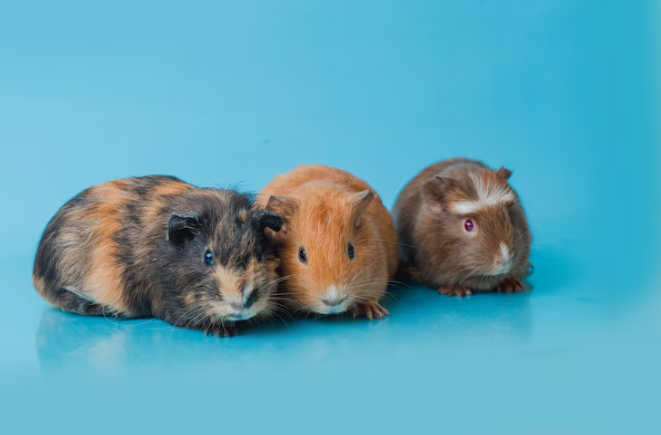
You can’t lump all cats into the same box. Some walk past a guinea pig like it's furniture. Others? Lock on like it’s a snack. That’s why vague advice falls apart fast. The risk lives in the individual cat, not the species label on the vet file.
What flips the switch from observer to predator? A few things. Let’s break it down.
● Prey drive: The big one. Cats with that twitchy, laser-eyed focus on anything small that moves? Not safe. Tail flicking, crouching, pupils blown wide—that’s a predator gearing up. Now, older or super chill cats might not react the same way. But don’t assume a gray muzzle means harmless. Some seniors still stalk.
● History matters: If your cat has a body count—birds, rodents, hamsters—it’s a no. Playing doesn’t soften the risk. Cats raised around small animals from the start? Different story. They might tune out the guinea pig completely.
● Energy and temperament: The high-strung ones are tougher. Bengals, Abyssinians, even hyper housecats—if they need constant action, a guinea pig cage becomes free entertainment. Mellow breeds might care less, but don’t bet on the breed alone. Watch how your cat reacts to new stuff. That’s your real clue.
● Barriers: Some cats are obsessed with what they can’t reach. Pawing at cages? Climbing furniture to get a better look? Not good. If your cat loses interest quickly and moves on—that’s the behavior you want.
● Training and control: Can you redirect your cat with a word? Will they back off when told? That matters. A cat that listens gives you leverage. One that ignores commands? That’s a risk you can’t manage.
The hardest truth? It’s not about trust. It’s about being honest about what you’re seeing. Misread the signs, and it’s the guinea pig that pays.
This isn’t a one-and-done moment. It’s slow. Cautious. Measured. A series of steps, not a scene from a cartoon where animals instantly bond. That’s not how this works. It’s all about staying ahead of the danger, not chasing outcomes.
● Step 1 — Separate zones, locked down: Before anything happens, that guinea pig needs to be sealed in. Think fully enclosed, no gaps, no exposed bars wide enough for a paw. Chew-proof helps. A cover on top and sides? Even better. Cats test weak points—they’re not subtle.
● Step 2 — Let the smell do the talking: Bring the cat into the room, and the guinea pig stays caged. No contact. Let scent carry the message. Your job? Watch like a hawk. Tail flicking, crouching, locked eyes? Shut it down right there.
● Step 3 — See but not touch: Still caged. The cat can look—ideally, while distracted by something else. Toy, treat, whatever. You’re scanning body language now. Soft ears. Lazy tail. Blink. Blink. That’s good. A paw lift or charge? Game over.
● Step 4 — Repeat. Slowly. On purpose: Ten minutes max. In and out. Do it daily, no shortcuts. Always with you present. Every time. You’re not desensitizing the cat—you’re measuring whether it can regulate itself at all.
● Step 5 — Stop at success: If the cat loses interest and walks away, end the session right there. That’s the win. Don’t drag it out. Reinforce that the cage isn’t a toy. It’s off-limits. Period.
Here’s the hard truth—most introductions don’t work. And that’s fine. If the cat isn’t stalking and ignores the guinea pig altogether? That’s your best-case scenario. Still, keep them apart. Always. All it takes is one slip. One paw. One panic. No redo.
Animals don’t wait until something big happens to let you know they’re unhappy. They whisper it. Quietly. Under their breath. Small shifts, tiny movements—things you could easily brush off, overlook, and regret later.
Cats do it. Guinea pigs definitely do it. But who notices? Usually, nobody. Not until afterward, when you’re thinking, ‘I should’ve known.’ If avoiding a disaster matters (and it should), pay attention. Spot those tiny warning signs early, trust your gut, and don’t wait for proof. Act fast.
Guinea Pig Warning Signs
Guinea pigs don’t scream. They hide, freeze, or shut down. Stress can escalate quickly and affect their health within hours.
Watch for:
● Freezing up the second the cat gets close
● Teeth chattering—not cute, not funny, that’s a back-off warning
● No interest in food, barely moving, just… checked out
● Breathing fast, short, kind of twitchy—like the body’s stuck in panic mode
● Always hiding, even when nothing’s going on, like it’s bracing for something
● Odd squeals, sounds that don’t fit—sharp, anxious, not normal chatter
Chronic stress in guinea pigs isn’t harmless—it can lead to GI stasis, a life-threatening condition.
Cat Warning Signs
Even calm cats can flip fast. If you're watching closely, their body language gives you the truth before their paws do.
Watch for:
● Tail twitching or thumping against the floor
● Dilated pupils or locked gaze on the guinea pig
● Crouching posture with back legs coiled
● Ears turned back or flat against the head
● Low growling or vocal rumbling
● Sudden lunges, even if the cage stops them
Any one of these is a clear warning. Stack two or more, and you’re sitting on a time bomb.
The safest setups come from prevention, not reaction. If either animal starts showing these signs, pull back immediately.
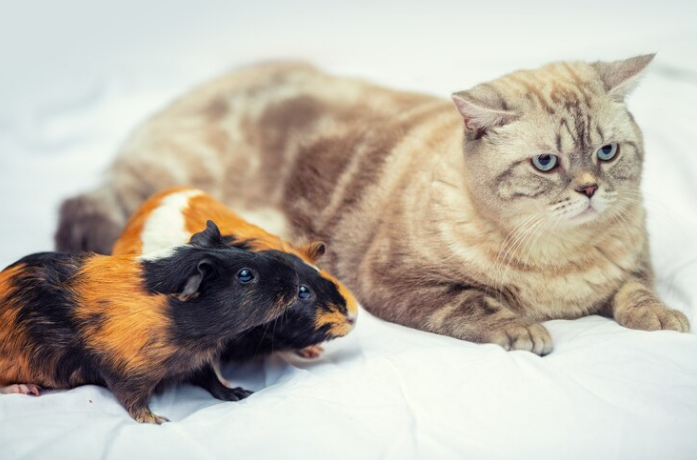
Coexistence without structure invites chaos. If you're housing both a cat and a guinea pig, the setup, supervision, and daily rhythm must be engineered for safety, not convenience. These aren’t optional tips. These are non-negotiable rules.
Physical Setup Rules
● Reinforced enclosures only: The guinea pig’s cage must be made of solid materials—no open bars wide enough for paws, no unsecured tops. Lid locks and weight-tested frames prevent forced entries or topples.
● Elevate the enclosure: Keeping the guinea pig’s habitat off the floor reduces the predator-prey dynamic. Use a table or custom shelf with wall clearance to prevent surrounding access.
● No open playpens or floor time in shared spaces: Under no condition should guinea pigs have floor time near cats, even briefly. All free-range time must happen in secured, cat-free rooms with doors closed and latched.
● Barrier inspections weekly: Over time, cats can loosen mesh, shift panels, or stress weak spots in enclosures. Conduct visual checks each week for warping, chew damage, or latch fatigue.
Supervision Protocols
● One room, one watcher, no distractions: If both pets are in the same room—even caged—you need full awareness. No headphones. No phone scrolling. All attention on behavior shifts.
● Keep it under 10 minutes: Long sessions? That’s where things start to slip. The longer it goes, the more likely someone gets twitchy. You see one tail flick or freeze-up? Done. Cut it. Reset. Try again later.
● Remove the cat first: Always remove the predator, not the prey. Picking up a guinea pig in front of a staring cat creates vulnerability. Secure the cat before handling the smaller animal.
Daily Routine Rules
● Feed them separately and out of sight: Feeding time can trigger competition or heightened awareness. Maintain separate rooms, separate schedules, and zero cross-access to food or water.
● Scent transfers only under supervision: Cats and guinea pigs learn through scent. Occasionally, swapping bedding or using clean cloths transfers is fine, but never leave scent-soaked items unsupervised in shared zones.
● Close and lock all doors during absences: Before leaving the house, confirm that the guinea pig’s space is locked and the cat has no access route, no matter how safe it seemed earlier.
Safety is not about training instincts out of animals. It’s about engineering a setup that prevents those instincts from being triggered in the first place. Anything less is a compromise that puts one life at risk.
Leaving a cat and a guinea pig unattended—even in separate zones—introduces risk. A closed door isn't always enough. Cats test limits. Guinea pigs panic easily. Monitoring matters. This is where smart feeders with built-in cameras fill a critical gap.
Something like the WOpet’s Pioneer Plus WiFi Automatic Pet Feeder with Camera isn't just about remote meals. Nope, it's more about knowing what's happening right now. Live look-ins whenever you want—see what your pets are actually up to. At work? In bed? Gone for a few hours? Still covered. Peek into the room, spot-check the situation, no guesswork.
And if you've got multiple pets, that's big. Not just curiosity, though that's normal, too. It's catching small stuff early, the stuff that spirals later. Peace of mind, basically.
You can:
● Visually confirm separation zones remain intact
● Spot unauthorized behavior like cage interference, pawing, or attempts to access other rooms
● Listen and respond using two-way audio if a stress noise or thud grabs your attention
● Control feeding schedules remotely to prevent cats from hovering near shared scent trails or food residue
Even models like the WOpet’s Heritage View Feeder with dual bowls and HD camera support complex routines by keeping feeding fully automated while giving you real-time insight. If separation is the rule, monitoring is the insurance. Smart feeders with cameras help close the distance between ‘safe enough’ and truly secure.
Hope doesn’t cut it. Not with animals wired this differently. If you’ve read this far, you already get it—coexistence takes structure. Real boundaries. Constant checking. And a little backup when you’re not there to step in.
We didn’t sugarcoat anything—some cats are flat-out risky around guinea pigs, even the ones that nap all day. You’ve seen what to watch for. How to read those weird, blink-and-miss-it stress cues. How to set up your space so nothing gets left to chance. No, ‘they’ll be fine.’ That’s out.
Now, here’s where tech actually helps. WOpet’s smart feeders with HD cameras? They give you that extra pair of eyes. They fill in the gap when you’re not in the room, not near the door, not checking every corner. You can feed from a distance, sure—but more importantly, you can see what’s happening. Live. Right when it matters.
Keep the cat where it belongs. Keep the guinea pig out of harm’s way. Create a setup that doesn’t unravel the second you leave the house. That’s the kind of system WOpet supports—quietly, reliably, without fuss.
Label:
Popular Post
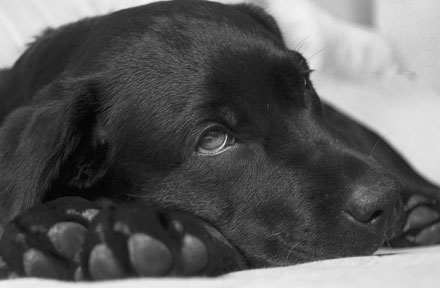
What to Feed a Sick Dog With No Appetite? [2025 Guide]
May 16, 2023
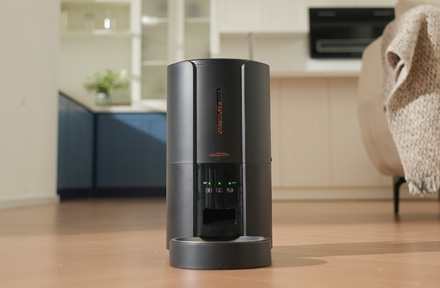
Troubleshooting Common Issues with Automatic Pet Feeders: Tips & Tricks for Pet Owners
Oct 26, 2023
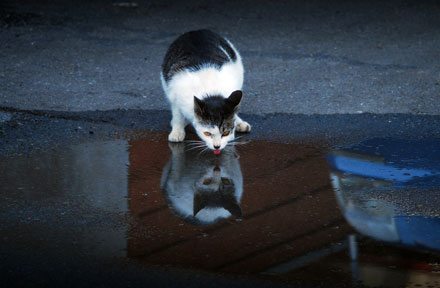
Why Does My Cat Cough After Drinking Water? 8 Potential Reasons
Mar 13, 2023
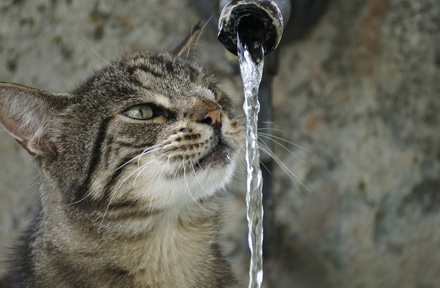
Why is My Cat Throwing up Water? Top 5 Causes Here
Feb 08, 2023
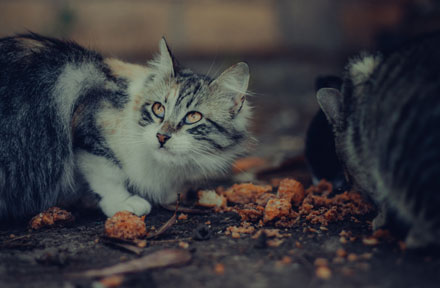
My Cat Only Eats A Little at A Time - What to Do?
Feb 27, 2023
$99.99
$129.99
Copyright © 2025 WOPET. All Rights Reserved.